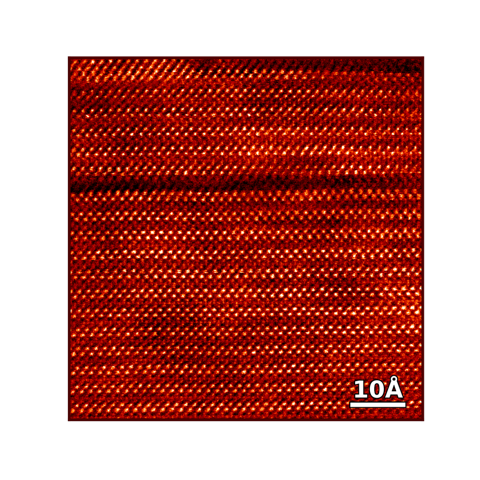A significant new grant has been awarded to establish a state-of-the-art electron microscopy facility at the University of Glasgow.
The School of Physics & Astronomy at the University of Glasgow has received a £4.9 million grant from the Engineering and Physical Sciences Research Council (EPSRC), a component of UKRI, to construct the new electron microscopy facility.
Researchers from the School have long-standing expertise in the study of functional materials, including the magnetic films used for data storage, materials for energy applications, and semiconductor technologies.

A high resolution of a crystalline material, showing a regular lattice of atoms. Deviations from the regular pattern are defects that often produce unusual material properties.
The new funding will allow them to develop enhanced electron microscopy
techniques to improve the spatial resolution for magnetic materials, down to the level of individual atoms. Such resolution has previously been limited by the need to immerse samples in the strong magnetic fields required to focus electron beams.
In addition, the new microscope will incorporate the latest improvements in spectroscopy to help study the chemistry and electronic properties of materials. A key advance will be to incorporate electron detectors developed by University of Glasgow researchers working in collaboration with CERN. These give unprecedented sensitivity and speed in detecting the electrons used for imaging samples in the microscope.
The new microscope, named MagTEM2, will replace an older instrument that was in its time also ground-breaking. It will help support materials projects across the University and will be accessible as a facility to national and international users from 2026.
Professor Stephen McVitie is principal investigator for the project. He said:
“Glasgow has been international centre for electron microscopy for more than 40 years and this new investment will now enable us to study magnetic materials on the atomic scale. This is critical because we collaborate with manufacturers to develop data storage devices using magnets that are only a few atoms in size.”
Co-investigator Professor Donald MacLaren said:
“Functional materials like batteries, semiconductors and sensor technologies underpin the modern world, but can be difficult to study with enough resolution in time, energy and space to fully optimise their performance. This new microscope will provide that resolution and help support the University of Glasgow’s ambition to lead the development of nano and quantum technologies.”
MagTEM2 will be housed at the University’s Kelvin Nanocharacterisation Centre.